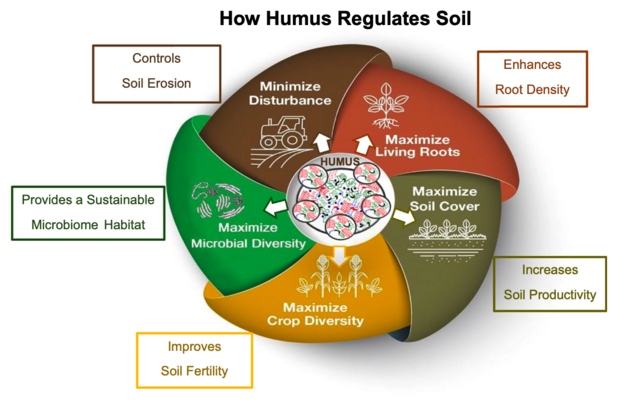Humus is good for soil health. But why is that? What exactly is humus, how is it formed and what functions does humus perform in the soil? In a review from 2025, Piccolo and Drosos investigate the importance of humus for soil health, the water balance, carbon storage and ecological sustainability. The researchers were able to show that humus - especially in its supramolecular form - is essential for physical stability, chemical fertility and biological activity in the soil.
How humus influences our soil climate
Figure 1: “How humus regulates the soil.” Graphic summary of important functions of humus in the soil.
Humus, soil, dirt. All the same thing?
Humus is humified organic matter. It is a dark, chemically stabilized organic substance in the soil, about 85% of which is formed from decomposed plant and animal matter. However, the process of humification of organic material is complex and has not yet been clearly defined, which is why humus does not have a clear chemical formula. The entirety of finely decomposed organic compounds in the soil is referred to as the “humeome”, similar to the genome, which refers to the entirety of all genes of a living organism.
From molecule to network
The authors describe humus as a supramolecular network. It is made up of a series of smaller molecules that are linked to each other via weak chemical interactions. Humus is therefore a loose agglomeration of different metabolic products of humification. This supramolecular structure reacts dynamically and sensitively to changing environmental conditions. Larger aggregates are formed at a neutral pH value and smaller, more stable aggregates at a low pH value. This new, dynamic view contrasts with the earlier view that humus can be interpreted as a large, rather static macropolymer.
Figure 2: pH-dependent structural change of humus in the soil. At a pH value above 4, humic molecules increasingly organize themselves into loose, supramolecular aggregates. If the pH drops, smaller, more stable aggregates are formed.
How humus works in the soil
The organic humus fragments can attach themselves to mineral (i.e. non-organic) soil components and form organic-mineral complexes. This creates larger soil particles and makes the soil less susceptible to erosion. At the same time, this loose structure is a good water reservoir, similar to a sponge, and increases the water absorption capacity of the soil. In the soil, humus significantly determines the physical, chemical and biological soil fertility. Among other things, humus promotes plant growth by increasing nutrient mobility and improving root architecture due to hormone-like effects. Humus components also have a positive influence on the composition of microbial communities in the root zone.
Humus in agricultural practice
In practice, these findings are used in all types of agriculture. In biodynamic and organic farming, however, the build-up of humus in the soil is a central concern and also one of the reasons why these types of agriculture can be described as “regenerative”: They not only use the soil, but enrich it in the long term. For example, humus-rich composts and humus preparations are used as soil conditioners and plant biostimulants to replace synthetic fertilizers and pesticides. Biodynamic preparations are important anaerobically humified substances to promote microbial activity in the soil and stabilize yields.
Biodynamics: Setting a good example
The confirmation of the effectiveness of humified organic matter such as preparation 500, which is produced by anaerobic ripening and has a high level of microbial activity, is particularly exciting from a biodynamics perspective. The study shows that such humus-rich preparations promote soil structure, root growth and plant vitality - entirely in line with biodynamic principles. It also emphasizes that even small amounts of well-structured humus-rich materials can have a major effect, which underlines the efficiency of biodynamic applications.
Comment
Piccolo and Drosos emphasize that the understanding of the humeome and the new supramolecular humus model pave the way for sustainable soil management that combines yield security with environmental protection. In doing so, they often rely on their own work and therefore risk generating a confirmation bias. In addition, the authors miss to consider the variability between soil types in a differentiated way. Nevertheless, the study provides important impulses for sustainable soil management.
Sources and further links to this article
- Original study:
- Piccolo, A., Drosos, M. The essential role of humified organic matter in preserving soil health. Chem. Biol. Technol. Agric. 12, 21 (2025).
https://doi.org/10.1186/s40538-025-00730-0 - Study report «Who is actually fertilizing whom?»
- Study report «DOK trial: Comprehensive publication after 45 years of field experiments»
- The study is covered by Creative Commons (link to license) and has been summarized for this study report.

